In a previous blog post we covered what types of exotic fish you can expect to encounter if you head to south Florida, but we only touched briefly on where you might search for a specific species. This installment will provide some guidance as to the “Where” part of the equation.

Find the Pattern
The easiest way to determine where to fish down south is to pick a fish species and identify the type of water characteristics it prefers. Once we establish the pattern then we can realistically expect to find them in different parts of the region that has water with similar characteristics.
 Why is south Florida such a hotspot for the exotics in the first place? It has everything to do with our subtropical temperatures and developers' need to move ground water and runoff in order to mitigate flooding, create dry land on which to build, or provide water for irrigation. Canals, ditches, and lakes of all types and sizes have been carved out of the sand and rock in order to move or hold water, and these areas provide prime habitat for some of our exotic fish species. Of special importance are those structures cut into the rock formations. These provide a solid substrate for nesting, craggy outcroppings to hide in, and ready access to deep water that offers safety and temperatures the fish find comfortable. The aquifer has been tapped in some places, which allows a continuous influx of water with consistent temperature, clarity, and quality. Combine these manmade features with those of the Florida Everglades and you’ve got fish heaven. Some mining operations in the region create superb habitat but you must be lucky or privileged to gain access to these areas. The same can be said for the countless golf courses with lakes just begging to be fished.
Why is south Florida such a hotspot for the exotics in the first place? It has everything to do with our subtropical temperatures and developers' need to move ground water and runoff in order to mitigate flooding, create dry land on which to build, or provide water for irrigation. Canals, ditches, and lakes of all types and sizes have been carved out of the sand and rock in order to move or hold water, and these areas provide prime habitat for some of our exotic fish species. Of special importance are those structures cut into the rock formations. These provide a solid substrate for nesting, craggy outcroppings to hide in, and ready access to deep water that offers safety and temperatures the fish find comfortable. The aquifer has been tapped in some places, which allows a continuous influx of water with consistent temperature, clarity, and quality. Combine these manmade features with those of the Florida Everglades and you’ve got fish heaven. Some mining operations in the region create superb habitat but you must be lucky or privileged to gain access to these areas. The same can be said for the countless golf courses with lakes just begging to be fished.
Water Temperature
Water temperatures ultimately limit how far north any of these exotics can range so don’t bother looking for peacocks in Jacksonville even though you may have found a lake that looks perfect structurally. Extreme or prolonged cold proves fatal to many of these species. We do experience population fluctuations from year to year, but rest assured some fish will survive even the coldest winter season to return their numbers fishable levels before too long.
By the Species
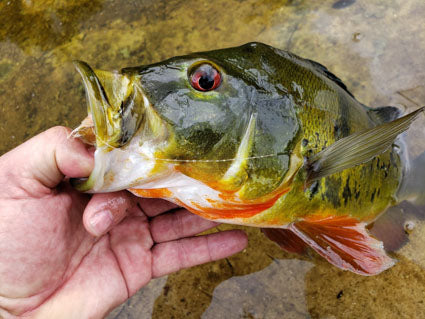
Let’s look at each fish and note what to look for when seeking them out.
Peacock Bass can be found in any water but the proximity to hard structure like rocks, ledges, bridge supports, or concrete culverts will draw these fish and should be the areas you concentrate on. I’ve found fish hanging around a single cinder block or even a resin chair resting in four feet of water. The point is, although peacocks may inhabit a lake, you should focus your angling efforts to areas with fish-attracting structure. Bank reinforcements made of boulders and/or concrete bags create prime holding areas that cannot be ignored by the fish and are deserving of a few casts even if you don’t readily see fish.
Tiger Oscars are absolute suckers for any formation created by vegetation both living and dead. Cattails, hydrilla, lily pads, downed trees, anything that gives them some place to hide and ambush small fish that swim by or insects that land on the water’s surface. I once caught five oscars on consecutive casts from beneath a floating grass matt that wasn’t much larger than the average home’s welcome matt. Although you may occasionally catch them swimming in the open, you’ll have more success by casting to cover and searching the edges for fish on the hunt. Flies that “accidentally” find their way into the bushes should be patiently worked free and fished out completely because what could appear more natural than a spider or cricket dropping right out of a tree?
Jaguar Guapote want a roof over their heads and you’ll rarely see them out in the open. They prefer to be out of the main current so you can expect to find one sitting in a corner, underneath a ledge, in a hole, or tucked into the branches of a nice brush pile. Look for the darkest, most secluded section of a canal with very little flow to it and you’ve found the home of Mr. Jaguar. Many of our favorite jaguar haunts are the least likely and least picturesque locations, so don’t pass up the little backwater ditches connecting larger bodies of water. I liken jaguar to a reef living grouper that sits back and snatches anything unlucky enough to venture past its hollow in the coral.
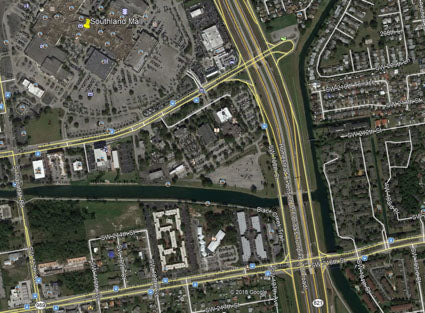
Midas Cichlid will force you to fish specific locations because they prefer the straight up-and-down rock walls of certain canal systems (like Black Creek or Cutler Drain Canal System) where the water is deep and clear. It’s not unusual to walk the banks of these canals spotting fish suspended along the canal walls like big sunflower blossoms. Fishing for midas cichlids can be a lot like vertical jigging for reef fish and I guarantee that any fish you do happen to hook is going to hug the wall and try to break you off.
Mayan Cichlids and Spotted Tilapia inhabit just about any mud puddle or creek that has water in it for more than a few months at a time. This versatility and adaptability means we will encounter them frequently regardless of the habitat. It also means that we have to endure their interference and high numbers before hooking into the fish we’re actually chasing. I’ve caught mayans from the Everglades to Merritt Island giving some indication of how widespread they are, and I’d be willing to bet that they make up a big portion of the exotics that anglers encounter when they head south. Spotted Tilapia haven’t expanded as far north so getting into the thick of them takes a little bit more driving and searching.
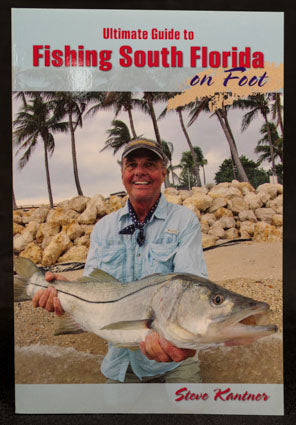
Tools and Resources
Steve Kantner’s book Fishing South Florida On Foot is a superb resource we strongly recommend people pick up if they’re considering regular forays south for either fresh or saltwater species. It contains many maps of the area, suggested fly patterns, and other equipment recommendations both fly and conventional. Steve is a font of knowledge that you should exploit as much as possible if you want to decrease the amount of time it takes to learn the ropes.
My two most valuable tools (beyond a favorite rod or two) are my laptop computer and cell phone because I’ll spend hours on end panning and zooming in on Google Earth satellite images, to find likely fishing spots. I’ll then find, and save as a favorite, the same location in my Android’s map application so I can readily navigate the maze-like streets of Broward County and the surrounding area. This process makes it easy to plan a day hopscotching from one spot to the next without wasting time. I’ll even go a step further by pre-planning stops based on who I’m fishing with, their casting ability, physical mobility, and stamina.
Good luck discovering your own “Honey Holes” full of your favorite exotic species in South Florida. A little time spent on research before you head south will set you up for success.




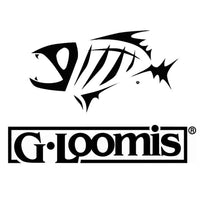


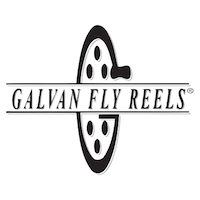







Comments